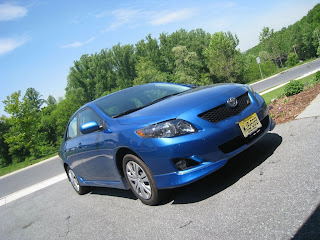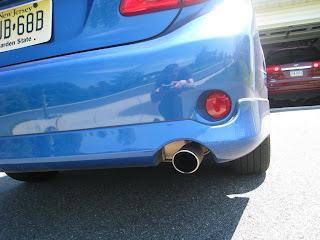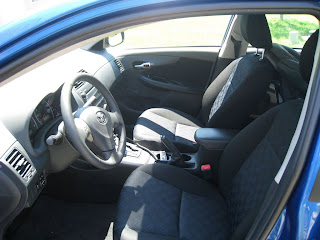2009 Toyota Corolla S Review
 Even though car sales have tanked so far during the first five months of 2008, the news isn’t bad for every car and every manufacturer. The Toyota juggernaut, although finally seeing its trend of 10% year-over-year growth end late last year, still enjoys several models that light up the sales charts. Among these is the venerable Toyota Corolla, which for many is a default choice when they are shopping for an economical car and are looking for the “safe” alternative. (By “safe,” I mean that it earns respectable crash-test ratings, has a legendary reliability track record, gets good fuel economy, and holds its value well.) A few months ago, Toyota launched an all-new Corolla as an early 2009 model. I decided to spend some time with one to see what kinds of sacrifices, if any, were necessary to drive a sub-$20,000 family car that has room for four and has highway fuel economy figures in the mid-30s.
Even though car sales have tanked so far during the first five months of 2008, the news isn’t bad for every car and every manufacturer. The Toyota juggernaut, although finally seeing its trend of 10% year-over-year growth end late last year, still enjoys several models that light up the sales charts. Among these is the venerable Toyota Corolla, which for many is a default choice when they are shopping for an economical car and are looking for the “safe” alternative. (By “safe,” I mean that it earns respectable crash-test ratings, has a legendary reliability track record, gets good fuel economy, and holds its value well.) A few months ago, Toyota launched an all-new Corolla as an early 2009 model. I decided to spend some time with one to see what kinds of sacrifices, if any, were necessary to drive a sub-$20,000 family car that has room for four and has highway fuel economy figures in the mid-30s.
The model that Toyota provided for my evaluation was a Corolla S, which is one model up in the hierarchy from the base model. Above the S, in order, are the LE, XLE, and XRS models. To the base Corolla, the Corolla S adds fog lights, power mirrors, ground effects, 16 inch wheels with plastic hubcaps, six speaker stereo, map lights, interior accents.
Exterior
 The 2009 Corolla, like the generation before it, borrows heavily from the styling of the larger Camry of the era. To me, however, the Corolla looks better than the Camry, which almost tried too hard to add a more engaging style with its most recent redesign for the 2007 model year. Instead, the Corolla has become (at least in S trim) arguably one of the least-stodgy looking compact cars. It has good proportions, reasonably short overhangs (particularly at the front), and some interesting character lines. My favorite styling feature is the way the hood’s cutlines pay homage to the trunklids of Bangle-era BMWs, and my least favorite is the way the shape of the C-pillar is too curved and seems out of touch with the rest of the car’s styling. The fact that the Corolla S comes with the ground effects and foglights in a model with a 1.8 liter engine and four-speed automatic is disappointing, in that the car’s performance can’t come close to cashing the checks that the “sporty” body is writing. I put “sporty” in quotes because, although I am still young enough to prefer sportier vehicles, I find the aero enhancements to be a little too close to the trying-too-hard era of Pontiac styling in the 1980s and 1990s.
The 2009 Corolla, like the generation before it, borrows heavily from the styling of the larger Camry of the era. To me, however, the Corolla looks better than the Camry, which almost tried too hard to add a more engaging style with its most recent redesign for the 2007 model year. Instead, the Corolla has become (at least in S trim) arguably one of the least-stodgy looking compact cars. It has good proportions, reasonably short overhangs (particularly at the front), and some interesting character lines. My favorite styling feature is the way the hood’s cutlines pay homage to the trunklids of Bangle-era BMWs, and my least favorite is the way the shape of the C-pillar is too curved and seems out of touch with the rest of the car’s styling. The fact that the Corolla S comes with the ground effects and foglights in a model with a 1.8 liter engine and four-speed automatic is disappointing, in that the car’s performance can’t come close to cashing the checks that the “sporty” body is writing. I put “sporty” in quotes because, although I am still young enough to prefer sportier vehicles, I find the aero enhancements to be a little too close to the trying-too-hard era of Pontiac styling in the 1980s and 1990s.
Interior
Since the interior is obviously where you’ll spend a lot of time, it’s arguably far more important than the exterior styling. The design was pleasant enough, with low-sheen plastics and a tasteful amount of metallic-looking accents. However, there was almost no place inside the car that was soft to the touch, unless it was covered in fabric. My expectations were somewhat tempered by the fact that the car stickered for about $18,000, but my 5,000-mile test vehicle was already showing signs of scuffing on the top of the dashboard, door panels, and along the center stack. The headliner and sunvisors were also somewhat disappointing (although again I must remind myself that this is a pretty basic car); the headliner felt like furry cardboard, and the sunvisors were vinyl covered and non-lighted.
 Also, $18,000 doesn’t get you as much as it used to. While the Corolla S comes with some nice features such as power locks, power mirrors, and a six-speaker stereo with CD/MP3 player, it also lacked power windows. I couldn’t remember the last time that I saw a new car without power windows. It was a strange adjustment to get used to cranking a window knob. The test vehicle also lacked cruise control, which made expressway travel in light traffic difficult to maintain a steady speed. Those two options, while available optionally, would have been deal breakers for me if I were buying the car and they were absent.
Also, $18,000 doesn’t get you as much as it used to. While the Corolla S comes with some nice features such as power locks, power mirrors, and a six-speaker stereo with CD/MP3 player, it also lacked power windows. I couldn’t remember the last time that I saw a new car without power windows. It was a strange adjustment to get used to cranking a window knob. The test vehicle also lacked cruise control, which made expressway travel in light traffic difficult to maintain a steady speed. Those two options, while available optionally, would have been deal breakers for me if I were buying the car and they were absent.
The seats were reasonably comfortable, and surprisingly, I found the interior to be more spacious in terms of legroom and headroom than the Lexus IS350 that I tested a few weeks ago. While we couldn’t comfortably ride in the Lexus as a family for more than 15 minutes, we undertook our Memorial Day weekend travel in the Corolla and were actually reasonably comfortable, once the seats were carefully adjusted. I am 6’4″ and my wife is just under 6′ tall, and we have two sons in child seats behind us. We even managed to fit a stroller in the trunk, although not much else.
The Corolla S had several storage compartments (including dual glove boxes and a center console on the small side), but I was disappointed that there was only a very small storage space within the center stack itself below the HVAC controls. It wasn’t even large enough to hold an eyeglasses case.
My favorite part of the interior, aside from its reasonably large usable space, was the steering wheel. It was small in diameter but leather wrapped (which I found surprising considering the very basic nature of the equipment in the Corolla S), and felt great in my hands. It also had duplicate audio controls to change the volume, preset, or mode.
Driving Impressions
One point eight liters of naturally aspirated four cylinder, connected to a four-speed automatic transaxle, does not get an enthusiast’s heart beating quickly. Actually, the powertrain did a great job in a few respects. The engine is extremely quiet at idle and had adequate power for most driving situations. In other words, if you were taking your parents – or wife and young children – for a ride in the Corolla and didn’t want to get a smack for driving too aggressively, you’d never notice that the Corolla’s 1.8 liter is lacking in power. However, driven more aggressively, the engine’s lack of power becomes apparent. It has to work hard to get every last horsepower, and isn’t afraid to buzz to let you know that it’s trying it’s best for you. Meanwhile, having only four transmission ratios requires that fourth gear be lower than it would otherwise probably be, so the engine is spinning faster at steady highway speeds than I’d like to see. Fuel economy on the highway was still very good, but I think it could be better with a six-speed automatic, or at least a five-speed automatic. (The Corollas equipped with the upsized 2.4 liter four cylinder come with a five-speed automatic, but it’s not available with the 1.8 liter four).
As with many other economical cars, the Corolla is equipped with electric power steering, and Toyota hasn’t mastered it yet for its cheap cars (that’s OK, most manufacturers haven’t either). The steering has a dead spot on center and doesn’t vary the effort required with the vehicle’s speed or road conditions. It was very isolated from the rest of the driving experience. As a result, the Corolla didn’t feel confident at all in curvy roads, particularly at higher speeds. The car felt like it floated too much; in spite of its visibly sporty exterior, the Corolla S apparently has the same suspension tuning as all other Corolla models. The numb steering and indifferent handling made me almost long for the agility of the Sequoia I had tested a week before. (I’m being facetious, of course, but it was definitely a driving experience that required some acclimation).
Fuel Economy
The Corolla S with the 1.8 liter four cylinder is rated at 26 mpg in the city and 35 mpg on the highway. With the standard five-speed manual, the rating is 27/35. Models with the larger 2.4 liter four cylinder are rated at 22/30 regardless of transmission choice (five-speed automatic or five-speed manual). The EPA rates the combined mileage of the 1.8 liter Corollas at 30 mpg and the 2.4 liter Corollas at 25 mpg. In about 300 miles of mixed driving (including 100 miles of a pure highway trip), my overall average was about 31 miles per gallon. The highway trip saw about 33 miles per gallon. Interestingly, the larger, more comfortable, more powerful (and unfortunately much more expensive) Camry Hybrid that I tested a few months ago achieved the same 31 miles per gallon combined.
Somewhat disappointing is that the 2009 Corolla’s fuel economy dropped from 28/37 in the outgoing 2008 model. While it’s a small drop in relative terms (one mpg worse in the city and two mpg worse on the highway), and the 2009 Corolla is larger and more comfortable than the 2008 model, I’m sure that if Toyota knew that gas prices would be $4 per gallon, they would have tried a little harder to at least match – if not exceed – the mileage ratings of the previous model.
Relative to its competition, the Honda Civic is rated at 26 city/34 highway with its 1.8 liter and five-speed automatic and 21/29 with its performance-oriented 2.0 liter and six-speed manual. A Nissan Sentra with the 2.0 liter and CVT is rated at 25/33. A Chevrolet Cobalt XFE (five-speed manual) is rated at 25/36, and a Ford Focus also a five-speed manual) is rated at 24/35. So, the Corolla’s mileage has fallen back to the rest of the pack rather than leading it as it had been doing with the previous generation.
Pricing
The base Corolla starts at $15,910 with a five-speed manual transaxle, including destination charge. The four-speed automatic costs $740. Moving up to the Corolla S will cost you about $1,100 more, although it’s primarily an appearance package. The Corolla LE is probably a better buy for most folks, and I’d imagine it’s more of a volume model, since it eschews the slightly immature-looking ground effects, but includes some interior niceties such as power windows, all for just $330 more than the Corolla S. The Corolla XLE is $900 more than the LE, and adds features such as optitron electroluminescent gauges and remote keyless entry. Finally, the top-dog XRS model starts at $19,420 including destination with the five-speed manual. It comes with the larger 2.4 liter four cylinder engine, 17 inch alloy wheels, and a leather wrapped steering wheel (which is only available in the S and XRS). Some models have leather seats ($1,192), a touchscreen DVD navigation (only $1,100), JBL audio ($795), and a power tilt and slide moonroof ($712). Checking most or all of the option boxes results in a somewhat non-economical MSRP of about $23,500. My test vehicle, which was a Corolla S automatic with only a six-disc CD changer, all weather guard package, and stability control, had an MSRP of $18,410. At that price, it’s getting very close in price to a lower-end midsize sedan. For example, TrueDelta shows a 2009 Corolla S being only $300 cheaper than a 2008 Malibu LS, and the Malibu includes considerably more standard equipment, such as power windows, four wheel disc brakes, stability control, etc. Sure, the Corolla will be cheaper to operate, but it’s also less comfortable.
Bottom Line
The Corolla is a car that is probably just the right size for folks who have young children who no longer need car seats, or have no children, and want a small, economical commuter vehicle. Hybrid-like fuel economy, a broad array of available options, and excellent resale values make the Corolla a prudent, easy choice for consumers. Driving enthusiasts will want to avoid the lethargic 1.8 liter engine/four-speed automatic combination, and rear drum brakes coupled with electric power steering and suspension that’s on the soft side do not yield a rewarding driving experience. As nearly anyone in the market for a compact car is likely to do anyway, be sure to keep the Corolla on your shopping list.




